
1. Bull Penis Soup, Bolivia
Called Caldo de Cardan, this soup contains bull penis and testicles, which, by the way, looks exactly like a bull penis and testicles. I got to taste this at the home of a local, and although I knew “caldo” meant soup, I wasn’t aware of what the “de Cardan” would be. However, it became obvious that I would be eating genitals as soon as the bowl was placed in front of me.
While the broth is flavorful, with herbs and spices, the actual “meat” is a bit too chewy for my taste. For many, the meal is like an inexpensive all-purpose medication, helping to aid fatigue, anemia, and hangovers. And like most foods that make you gag at the thought, bull penis soup is considered an aphrodisiac.
Feeling: Healthy
Rating: 7/10
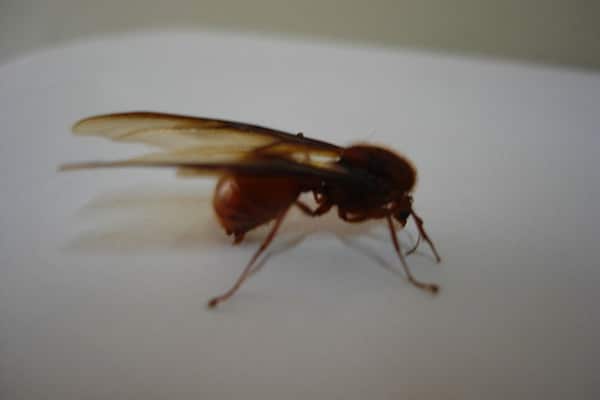
Hormiga
2. Big Butt Ants, Colombia
In Colombia, Big Butt Ants, or Hormigas Culonas, are snacked on like cocktail nuts. The delicacy is so highly sought after, they bring in ten times the amount of money per pound than Colombian coffee.
The preparation is a bit like a horror movie, as the ant is held in place, its head snapped quickly and without mercy. Next, the wings and pincers are plucked, and the body is left to soak overnight in salt water before it is fried. The finished product tastes and chews like bacon bits. Some consider it an aphrodisiac. I wonder if these people have ever tried wine and porn?
Feeling: Guilty
Rating: 3/10
3. Coconut Grubs, Ecuador
Coconut grubs — larvae that live in dead palm trees — are mainly eaten in the Amazon jungle. To help keep them flavorful, the stomachs are removed so you don’t taste the wood they dine on. From there, they’re marinated in wild orange and grilled. They’re actually delightful and crunchy, as long as you can forget you’re eating a fat, just-hatched insect from the rainforest. If you want a unique Amazon experience, and like the taste of citrus and peanuts, try this.
Feeling: Relaxed
Rating: 9/10
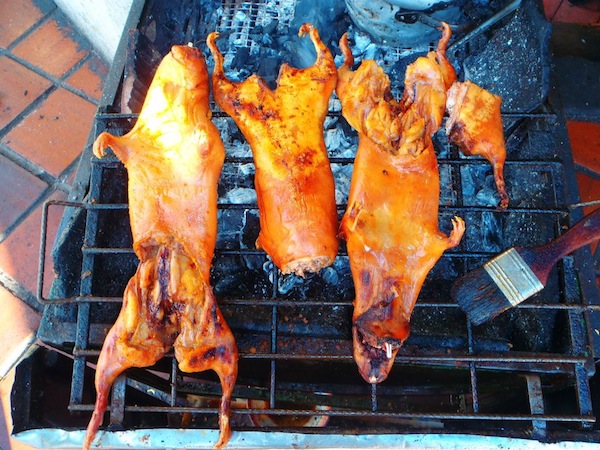
4. Cuy, Andes Mountains
You may recognize these little guys as your childhood pet. Cuy, or guinea pig, is a common Andean staple eaten throughout Peru and Ecuador, and in parts of Bolivia and Argentina. The animals are fed special diets, like lemongrass and yellow carrot, that give them a distinct flavor. They are served whole with the head and feet still on. Once I got past that, guinea pig was actually pretty delicious, with a greasy chicken flavor. In fact, it became my favorite food in Ecuador.
Feeling: Surprised
Rating: 10/10
5. Llama Brain And Tongue, Bolivia
While eating llama meat isn’t so strange, eating brains of any kind is a lot to handle. And eating a tongue is almost like French kissing the animal. However, in Bolivia, where llamas are the national animal and are used for everything from clothing to fetus rituals to labor to food, llama brains and tongue are considered a delicious meal.
As a westerner, the brains almost brought me to vomit from the slimy texture, although the tongue was firmer and a bit easier to eat, as long as you don’t see it being prepared. For something a little more digestible, try the salted dried llama jerky, which I actually snacked on religiously.
Feeling: Resourceful
Rating: 2/10
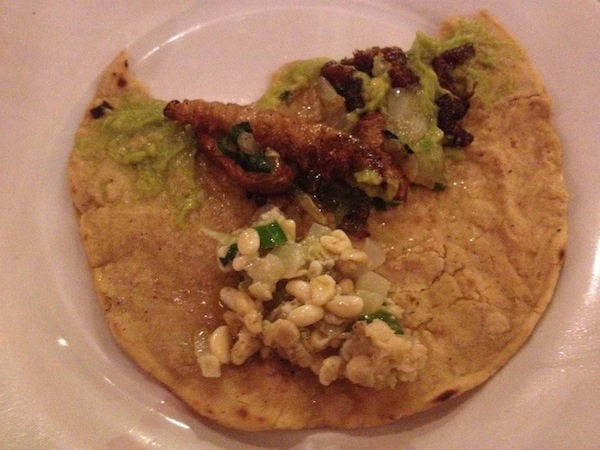
6. Ant Eggs And Worm Tacos, Mexico
I ordered this dish in an upscale restaurant in Puebla called El Mural de los Poblanos. A local friend told me about how eating these insects, called Hormigas Escimoles (the ants) and Guasanos (the worms), is a delicacy in Mexico, and very typical.
The insects are cooked over an open fire in a pan, then presented with tortillas and guacamole to make soft tacos. While the worms have a distinct mesquite flavor, the ant eggs reminded me a lot of eating a sunny-side-up omelet. While the dish looks unappetizing, it’s actually very delicious, especially with some onions added.
Feeling: Satisfied
Rating: 9/10
7. Moripan, Argentina
I accidentally ordered this having no idea what it was because it was cheap. I knew “pan” meant bread, and although I wasn’t sure what “mori” was, I figured it couldn’t be that different from its delicious sister, the juicy sausage sandwich called choripan. Oh, how wrong I was. Moripan is actually blood sausage wrapped in cow intestine. While the dried blood has a mushy, bean-like texture and flavor, the intestine was extremely hard to chew.
Feeling: Embarrassed
Rating: 5/10
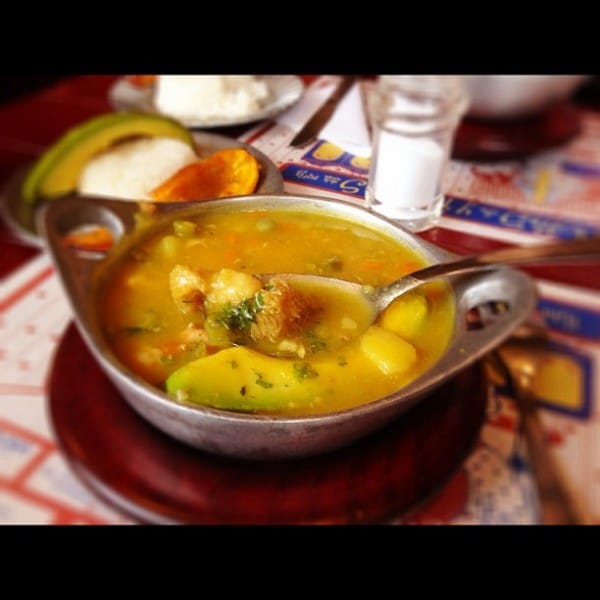
8. Mondongo, Colombia
Just enough cud flavor to let you know you’re eating stomach. Photo: alextorrenegra
The name of this dish sounds like a new Latin dance craze. In reality, it’s a soup made of cow stomach and entrails. They use all four stomachs of the cow to make it, and it also includes carrots, peas, avocado, and potatoes. The stomach has a chewy texture, which goes well with the thickness of the soup.
Feeling: Excited
Rating: 9/10
9. Chicha, Amazon Jungle
There are different varieties of chicha around South America. This traditional corn beer is made by the chicha maker chewing and moistening the corn in his mouth, which he then molds into small cakes with his teeth. These are laid out in the sun to ferment.
Natural enzymes in the human saliva convert corn starch into sugar, allowing for the beginning of the fermentation process. If offered the uniquely brewed beer, it is considered rude to decline, so you’ll need to forget what you know and just chug away. The beer is boiled before served, so technically it’s sterile, but still.
Feeling: Disgusted
Rating: 2/10
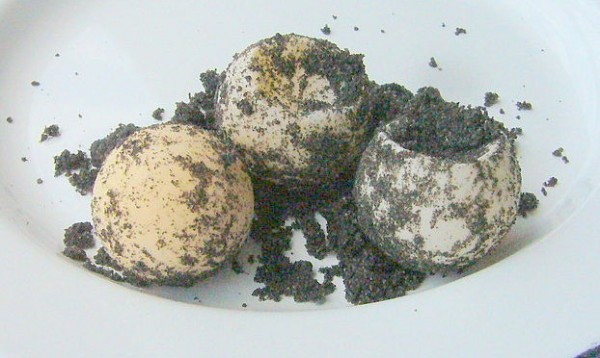
10. Huevos de Tortugas, Nicaragua
Although eating sea turtles is looked down upon in most parts of the world, it is part of the culture in Nicaragua. Huevos de tortugas involves eating the eggs of turtles, which have a very soft shell.
A hole is made at the top of the raw egg, and hot sauce or lemon juice is squeezed in to help cure the concoction, followed by a shot of rum. Not only is the meal very odd, it’s also dangerous. When eating sea turtle eggs, you’re also ingesting toxins, bacteria, and pollutants. I’ll leave turtle eggs for creating life, not eating.
Feeling: No way
Rating: 0/10
Photo Credit: flickr

Jessica Festa is the editor of the travel sites Jessie on a Journey (http://jessieonajourney.com) and Epicure & Culture (http://epicureandculture.com). Along with blogging at We Blog The World, her byline has appeared in publications like Huffington Post, Gadling, Fodor’s, Travel + Escape, Matador, Viator, The Culture-Ist and many others. After getting her BA/MA in Communication from the State University of New York at Albany, she realized she wasn’t really to stop backpacking and made travel her full time job. Some of her most memorable experiences include studying abroad in Sydney, teaching English in Thailand, doing orphanage work in Ghana, hiking her way through South America and traveling solo through Europe. She has a passion for backpacking, adventure, hiking, wine and getting off the beaten path.








